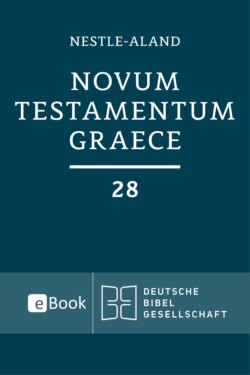Читать книгу Novum Testamentum Graece (Nestle-Aland) - Группа авторов, Nestle-Aland - Страница 46
2. Critical Signs Used in the Text
ОглавлениеCritical signs in the text (°, ⸋…⸌, ⸀ etc.) refer to the critical apparatus, and are explained in that connection (cf. below pp. 56*f.). These are the traditional signs of Eberhard Nestle's editions. They indicate the variants in the apparatus accurately and efficiently, with the advantage of alerting the reader to both their location and their nature without having a look away from the text. Readers who are interested only in the text can easily ignore them.
[ ]
Square brackets in the text ([ ]) except in the case of the Catholic Letters indicate that textual critics today are not completely convinced of the authenticity of the enclosed words (cf. Mt 18,19; Ac 16,1). These passages are always noted explicitly in the apparatus so that the reader may evaluate them independently. The reading given in the text shows the preference of the editors. For practical reasons the evidence given in the apparatus always includes the support for the reading in the text. Square brackets always reflect a great degree of difficulty in determining the text.
♦
The sign ♦ (diamond) indicates passages where the guiding line is split in the second edition of the ECM, because there are two variants which in the editors' judgement could equally well be adopted in the reconstructed initial text. In the ECM apparatus the alternative variant is marked with ♦ as well. In the present edition the diamond precedes the reference sign of the respective variant passage and the variant text in the apparatus. This does not mean that the editors regard the text as definitively established in all other passages. However, square brackets and other signs are no longer seen as suitable for expressing different degrees of reliability in the reconstructed initial text. This requires more sophisticated forms of presentation, like a text-critical commentary.
⟦ ⟧
Double brackets in the text (⟦ ⟧) indicate that the enclosed words, generally of some length, are known not to be a part of the original text. These texts derive from a very early stage of the tradition, and have often played a significant role in the history of the church (cf. Jn 7,53-8,11).
✽
For asterisks in the text (✽) cf. p. 85*.
Quotations from the Old Testament are printed in italics.
